An omnichannel contact center is a customer service model that allows people to engage with businesses across multiple communication channels and devices seamlessly and consistently.
The omnichannel approach essentially breaks down the silos between previously disconnected channels like phone, email, chat, social media, and more.
It stitches these touchpoints together into a unified customer journey.
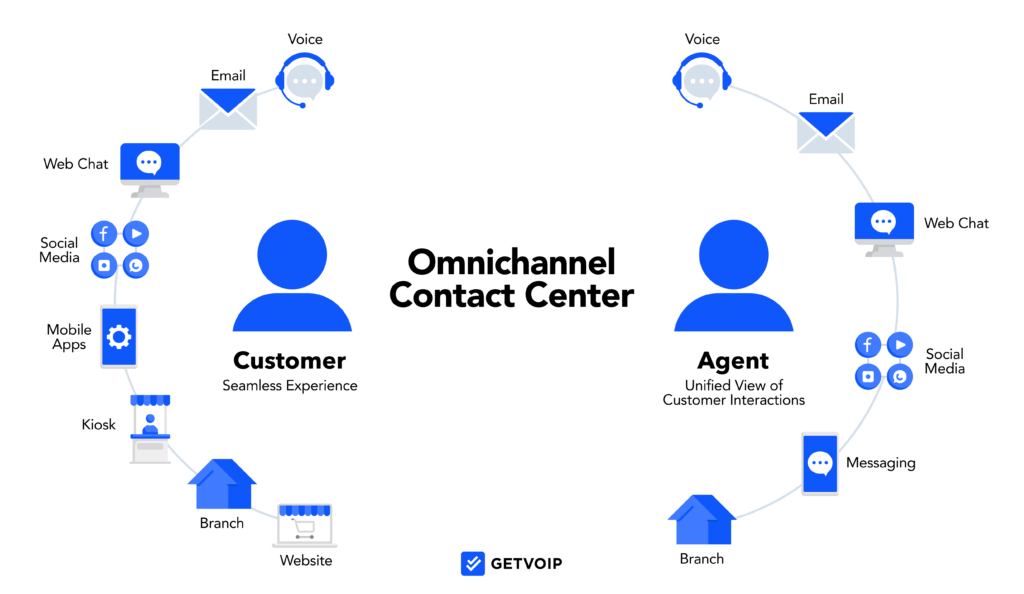
In an omnichannel model, conversations and interactions started on one channel can be picked back up on another channel.
For example, a customer query initiated through a website chatbot could be transferred to a human agent over voice call if needed.
The agent has full context about the prior chatbot conversation and can continue assisting the customer.
Key capabilities that enable this unified omnichannel experience include:
- Cross-channel customer identification and tracking
- Consolidated customer data and history shared across channels
- AI-powered intelligent routing across channels
- Unified agent desktops and workflows across channels
- Channel switching enabled for both customers and agents
Omnichannel centers leverage cloud technologies to connect previously disparate channels and information sources.
This gives customers the freedom to use their preferred mode of communication without losing context.
Meanwhile, agents can provide personalized, efficient service with full visibility into the customer’s needs and history.
Multichannel vs Omnichannel Customer Engagement
While omnichannel customer engagement aims to provide a seamless experience across channels, multichannel engagement simply means allowing customers to connect through different contact points. These channels usually operate in silos.
In a multichannel setup, there is no continuity when customers switch between channels. Conversations are isolated within channels, without any carryover of context between them.
Agents may lack insights from previous interactions on other channels when assisting customers.
In contrast, omnichannel centers integrate information across channels to enable smooth transitions and personalized experiences based on full customer history.
Omnichannel aims to meet customers on their terms. It delivers convenience, consistency, and personalization across the customer journey.

Key Benefits of Omnichannel Customer Engagement
There are several compelling benefits to the omnichannel customer service model:
1. Enhanced Customer Experiences
Omnichannel engagement puts the customer front and center. Customers can seamlessly flow between their preferred channels and devices on demand.
A hotel guest could book via the website, modify the reservation via the mobile app, and get customer support via Twitter DM – while receiving consistent service.
2. Increased Efficiency
With unified systems and customer data shared across channels, agents have the full context to resolve customer needs faster. Customers spend less time switching channels or re-explaining issues.
3. Higher Productivity
Agents equipped with omnichannel desktop tools and a complete view of the customer can handle more interactions in less time.
Intelligent routing also ensures customers are paired with the right skilled agent.
4. Improved Customer Intelligence
Omnichannel analytics provides a clear view across customer touchpoints.
Businesses gain actionable insights into channel preferences, journeys, pain points, and segment profiles. This allows the optimization of experiences.
5. Lower Operational Cost
By streamlining technology, workflows and information access, omnichannel setups drive efficiency. Automation of simple interactions via chatbots and AI routing also lowers costs.
6. Enhanced Personalization
Unified customer data enables more personalized service across channels based on preferences and history.
VIP customers can be identified for differentiated treatment. Follow-up interactions can be tailored.
7. Consistent Brand Experience
Maintaining a consistent brand voice, style, and customer experience across channels develops trust. Customers feel confident they’ll have a smooth experience regardless of channel.
Features of an Omnichannel Contact Center Platform
Delivering omnichannel customer experiences requires robust contact center technology with key capabilities:
1. Cross-Channel Customer Identification
The platform must maintain a single customer profile across interaction channels through identifiers like phone number, account number, loyalty number, etc.
2. Consolidated Interaction History
All customer conversations and touchpoints across channels get logged in one place. Agents get a chronological view of the cross-channel customer journey.
3. Unified Agent Desktop
Agents access a single workspace to manage customer interactions across channels like voice, email, chat, social media, etc.
4. Omnichannel Routing
Intelligent routing directs each contact to the appropriate agent resource based on skills, capacity, and channel preferences. Routing can happen across channels.
5. Channel Switching
Customers can switch channels on demand, for instance moving from chat to voice. Agents can also transfer interactions between channels without losing context.
6. CRM Integrations
Customer data from CRM systems is readily available to agents within their workspace and flows across channels. Agents have access to purchase history, preferences, etc.
7. Contact Center Analytics
A unified reporting dashboard provides insights across channels – like channel volumes, resolutions, CSAT scores, and more. Data drives optimization.
8. APIs and Integration
The platform provides open APIs and seamless integrations that allow companies to easily add emerging messaging channels as needed.
9. Cloud-Based Delivery
Omnichannel platforms leverage cloud hosting, enabling anywhere access, automatic updates, and usage-based pricing.
Several best practices enable are several best practices that enable contact centers to gain maximum value from omnichannel customer engagement:
10. Customer-Centric Strategy
Omnichannel initiatives should ultimately deliver personalization, convenience, and continuity from the lens of the customer journey – not operational silos. Keep evolving based on customer feedback.
11. Break Down Channel Silos
Design unified workflows that allow seamless coordination between teams managing different channels. Share knowledge, governance, and standards across groups.
12. Enable Consistent Branding
Maintain consistent identity, terminology, messaging tone, visuals, product information, and compliance across channels. Customers should feel a uniform brand experience.
13. Empower Agents
Equip agents with the skills, knowledge, and tools to quickly access information and deliver excellent service across channels. Provide comprehensive training.
14. Focus on Transition Points
Pay special attention to enabling smooth hand-offs between channels. Set clear protocols for transfers and channel switching to prevent drops.
15. Choose Flexible Technology
Evaluate omnichannel platforms based on open architecture, ease of integration, scalability, and analytics. Prioritize the channels your customers use most.
16. Drive Continuous Improvement
Continuously gather cross-channel analytics and customer feedback to identify areas for improvement. Refine routing rules, integrations, and self-service tools.
17. Leverage AI Thoughtfully
Use automation and AI judiciously – not as full replacements for human connection but to complement it.
AI chatbots can handle common queries, while complex issues route to agents.
18. Evaluate Performance Holistically
Evolve metrics to capture omnichannel success beyond channel-specific stats. Prioritize CSAT, handle times, first contact resolution, and customer effort scores.
19. Collaborate Across Teams
Encourage collaboration between groups managing different channels to share insights and develop integrated programs. Break down internal silos.
20. Verify Governance & Compliance
Review policies, processes, and audit controls across channels. Ensure regulatory compliance for data security, financial transactions, communications monitoring, etc.
21. Consider Hybrid Staffing Models
Omnichannel operations benefit from balancing in-house and outsourced staffing. Core agents provide tenured expertise, while variable supplemental staff help manage peaks.
By following these best practices, contact centers can transform disjointed multichannel operations into connected, customer-centric omnichannel experiences. The unified approach enhances satisfaction while driving efficiency across service channels.
Best Omnichannel Contact Center Providers
An omnichannel contact center allows customers to interact with companies through multiple channels like phone, email, live chat, social media, and more.
Having an omnichannel strategy improves customer satisfaction by providing consistent and seamless experiences. Below are 5 leading providers of omnichannel contact center solutions.
1. Five9
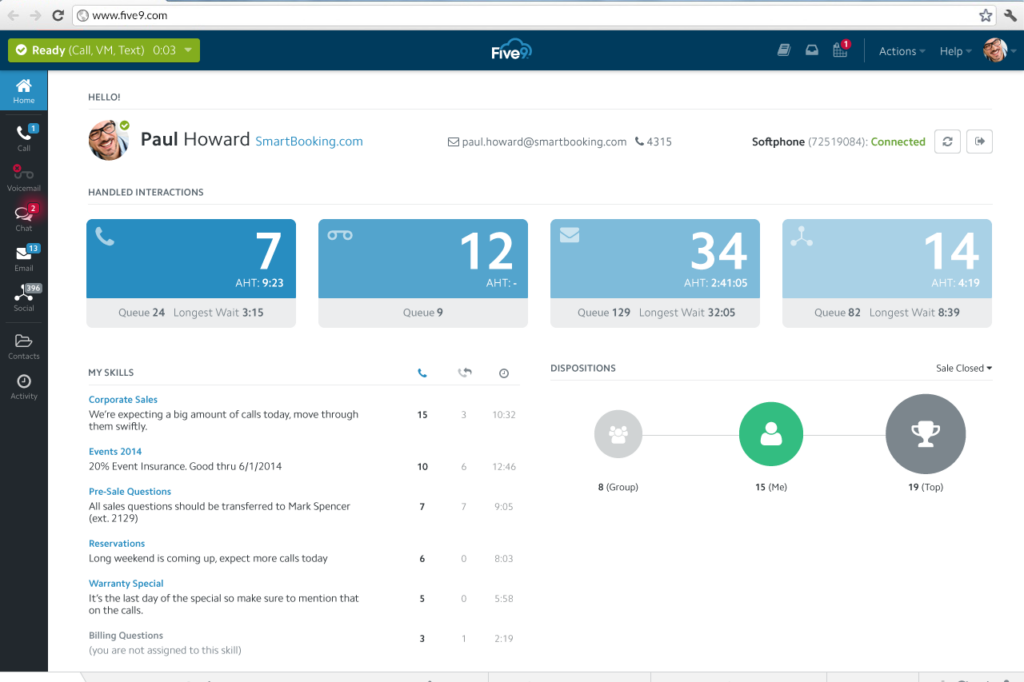
Features
- Cloud-based contact center platform
- Integrations with CRM, analytics, workforce management
- Omnichannel routing for voice, email, chat, social media
- AI-powered virtual agents and interactive voice response
- Real-time dashboards and reporting
Pricing
- A monthly subscription based on the number of agents
- Scales from small to enterprise-level deployments
- Actual pricing is not publicly listed and requires a quote
Why Pick Five9
Five9 is a pioneer in cloud contact centers.
Their platform is flexible, scalable, and full of features to support omnichannel customer engagements. The vendor focuses specifically on contact center solutions.
2. NICE InContact
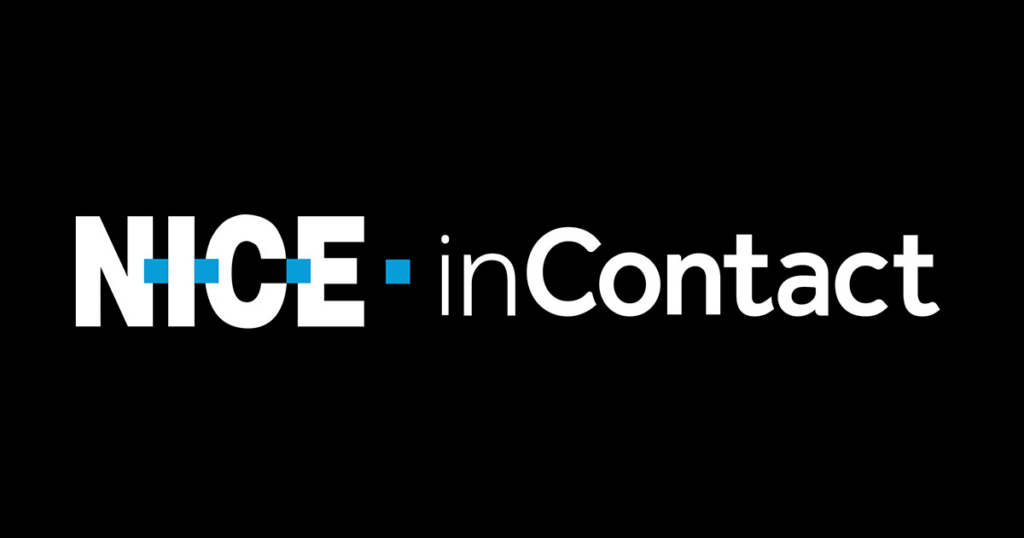
Features
- Unified cloud contact center suite
- Omnichannel routing and management
- Voice, chat, email, SMS, social media channels
- CRM integrations and analytics
- AI-driven self-service and automation
Pricing
- Monthly per agent, supervisor, and admin
- Scales from small business to enterprise
- Published pricing starts at $45 per agent
Why Pick NICE InContact
NICE InContact offers an end-to-end omnichannel contact center platform.
Their solution is easy to deploy, integrate, and manage. The company has over two decades of experience.
3. Talkdesk
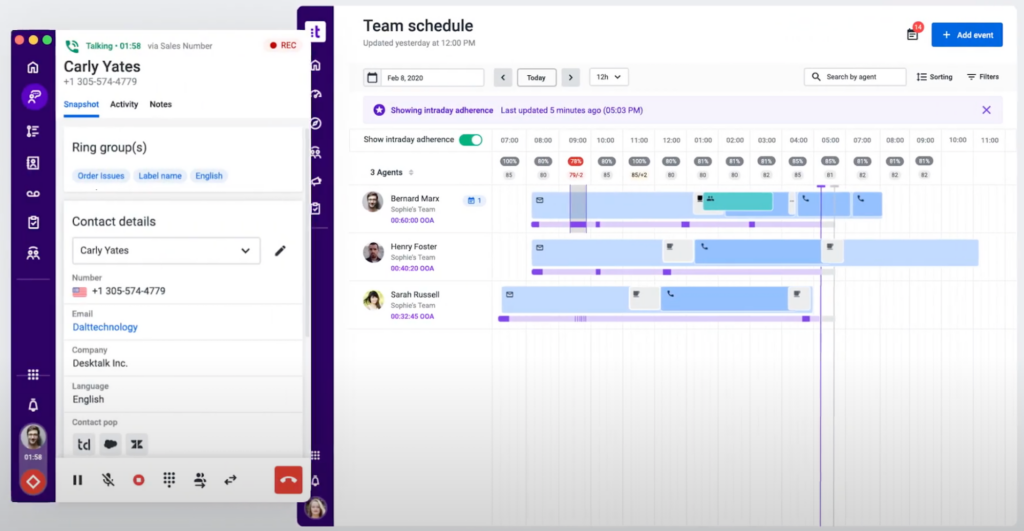
Features
- Cloud contact center with omnichannel capabilities
- Integrated phone, chat, email, social and self-service
- Customizable agent desktop and workflows
- CRM integrations, analytics, and reporting
- AI for routing, automation, and sentiment analysis
Pricing
- Monthly subscription tiers based on features
- Scales from small business to enterprise
- Published pricing starts at $29 per agent
Why Pick Talkdesk
Talkdesk is one of the top cloud contact center platforms. They focus on delivering excellent customer experiences across channels.
Talkdesk offers enterprise-grade features with quick and easy deployment.
4. Genesys
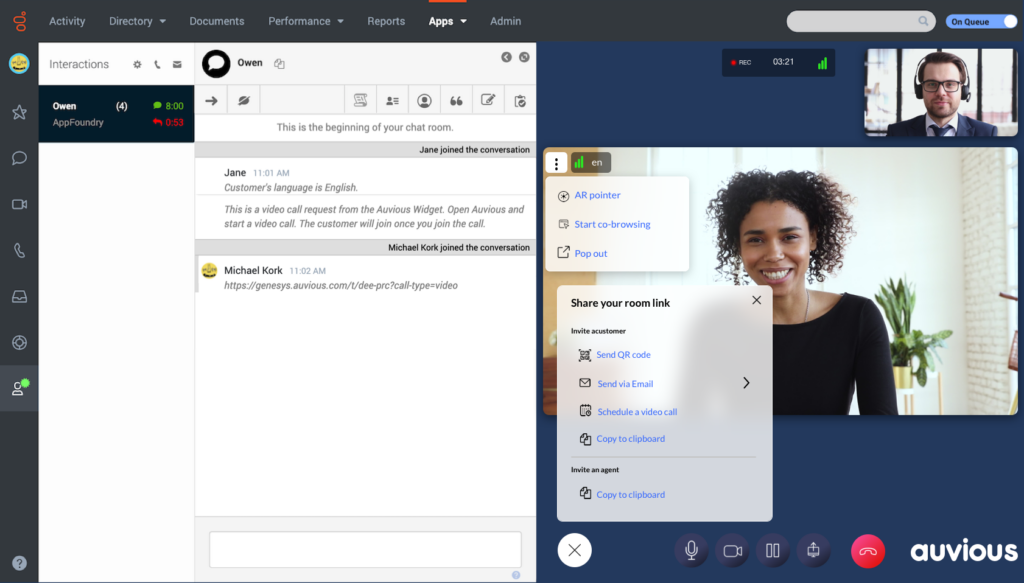
Features
- On-premises, cloud, and hybrid deployment options
- Routing and management for all major channels
- Flexible integration options and app marketplace
- Customer journey analytics and reporting
- AI, automation, and workforce optimization
Pricing
- Quote-based customized pricing
- Scales to very large, complex environments
- High-end enterprise pricing
Why Pick Genesys
Genesys is an industry leader trusted by large global enterprises. They offer highly scalable and customizable contact center platforms deployed on-premises or in the cloud. Genesys focuses on customer experience and agent empowerment.
5. 8×8

Features
- Integrated voice, video, chat, and contact center
- Omnichannel routing and management
- Pre-built CRM integrations
- Real-time and historical analytics
- Global coverage and reliability
Pricing
- Monthly per agent for contact center
- Bundled plans with voice and video
- Mid-market to enterprise pricing
- Published pricing starts at $55 per agent
Why Pick 8×8
8×8 provides an integrated cloud communications and contact center platform.
Their solution bundles voice, video, chat, and contact center capabilities. Reliability and global deployment are key strengths.
Conclusion
Omnichannel customer engagement is crucial to meet modern customer service expectations. Siloed channels and fractured experiences no longer suffice.
Companies must urgently embrace omnichannel to remain competitive. When executed well, omnichannel contact centers enhance customer loyalty, improve agent productivity, and provide a significant competitive edge through superior experiences.
With powerful new technologies like AI and the cloud, delivering connected customer journeys across channels has become an achievable reality.
Frequently Asked Questions (FAQ)
Ques 1: What channels can be part of an omnichannel strategy?
Ans: Typical channels include voice, email, chat, SMS/text, social media, video, web and mobile apps. Emerging channels can also be integrated as they arise.
Ques 2: Does omnichannel replace human agents?
Ans: No, the goal is to empower agents by providing a complete view of the customer across channels which improves their efficiency.
Ques 3: What technologies enable an omnichannel contact center?
Ans: Key technologies include UCC platforms, CRM software, cloud infrastructure, analytics, self-service tools, and API integration.
Ques 4: How is an omnichannel contact center different from a multichannel?
Ans: Omnichannel unifies historically siloed channels into a single integrated system, while multichannel operates channels separately.
Ques 5: Why do customers prefer omnichannel engagements?
Ans: Customers appreciate the convenience, speed, and continuity of moving seamlessly between channels for unified experiences.






